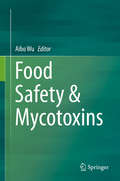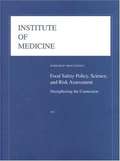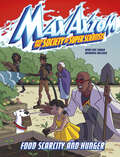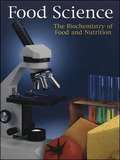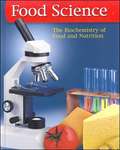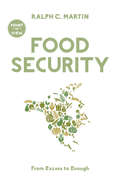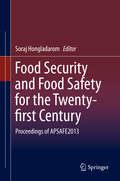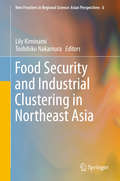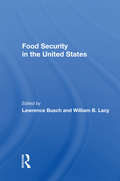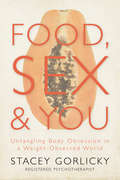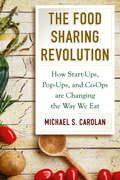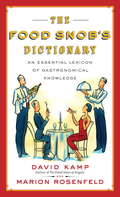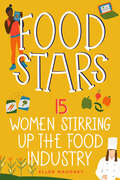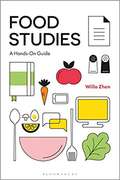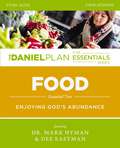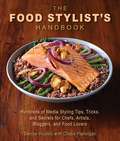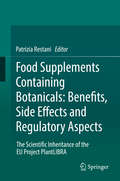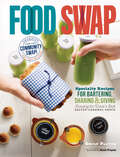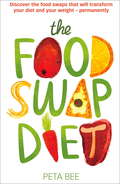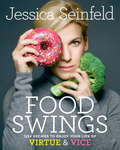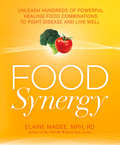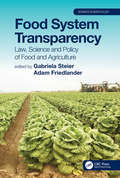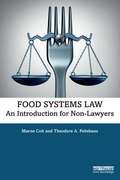- Table View
- List View
Food Safety & Mycotoxins
by Aibo WuMycotoxins are increasingly attracting attention at thegovernmental, public and academic level worldwide, due to more frequent and serious contaminations of food and feedstuffs, which pose a serious threat to human health and animal production. This book reviews the latest research on mycotoxins that directly concern food safety, and especially focuses on detection technologies, risk assessment and control strategiescurrently being used in China. Gathering contributions from over 20 respected researchers, the book will benefit graduatestudents, researchers and management groups from various disciplines, including food science and technology, analytical chemistry, plant pathology, public health, etc.
Food Safety Policy, Science, and Risk Assessment: Workshop Proceedings
by Food ForumThe National Academies Press (NAP)--publisher for the National Academies--publishes more than 200 books a year offering the most authoritative views, definitive information, and groundbreaking recommendations on a wide range of topics in science, engineering, and health. Our books are unique in that they are authored by the nation's leading experts in every scientific field.
Food Scarcity and Hunger: A Max Axiom Super Scientist Adventure (Max Axiom and the Society of Super Scientists)
by Myra Faye TurnerEvery year, the world’s farmers produce a lot of food for people to eat. Yet every night, millions of people around the world go to bed hungry. Why are people going without food when the earth is able to produce so much? In this nonfiction graphic novel, Max Axiom and the Society of Super Scientists go on a fact-finding mission to discover the reasons behind food scarcity. Young readers can join the team to find out why many people deal with food insecurity and learn ways that they can help.
Food Science: The Biochemistry of Food and Nutrition (4th Edition)
by Kay Yockey Mehas Sharon Lesley RodgersEnhance your program by offering a Food Science course! This high-interest Food Science text teaches students to use the scientific method as they study the biological and chemical bases of food and nutrition.
Food Science: The Biochemistry of Food and Nutrition
by Kay Yockey Mehas Sharon Lesley RodgersIn Food Science: The Biochemistry of Food and Nutrition students learn to use the scientific method as they study the biological and chemical basis of food and nutrition. The text combines scientific principles with real-life applications of food preparation and nutrition. It is taught by the Family and Consumer Sciences teacher, a Science teacher, or by the two together. Students will learn to apply scientific principles of food and nutrition as they explore foods and nutrition using basic scientific equipment. Measurement, use of equipment, problem solving, reasoning skills and writing are emphasized. This flexible text format is adaptable to a one or two semester course.
Food Security: From Excess to Enough (Point of View #9)
by Ralph C. MartinCanadians are failing to balance reasonable food consumption with sufficient and sustainable production. The modern agricultural system is producing more and more food. Too much food. The cost is enormous: excess nutrients are contaminating the air and water; soil is being depleted; species loss is plunging us toward the sixth extinction; and farmers, racking up debt, are increasingly vulnerable to economic and climatic shifts. At the same time, people are consuming too much food. Two-thirds of health-care costs in Canada can be attributed to chronic diseases associated with unhealthy eating. And then there is the waste — householders, food processors, distributors, wholesalers, and retailers collectively waste 40 percent of the food produced. A radical rethink is required. We need to move from excess to enough.
Food Security and Food Safety for the Twenty-first Century
by Soraj HongladaromThis book is a collection of selected papers that were presented at the First International Conference of the Asia-Pacific Society for Agricultural and Food Ethics (APSAFE 2013), which was held at Chulalongkorn University from November 28 - 30, 2013. The papers are interdisciplinary, containing insights into food security and food ethics from a variety of perspectives, including, but not limited to, philosophy, sociology, law, sociology, economics, as well as the natural sciences. The theme of the conference was to consider the interplay and balance between food security and food ethics as the world approaches the middle part of the twenty-first century.
Food Security and Industrial Clustering in Northeast Asia
by Lily Kiminami Toshihiko NakamuraThis book integrates diversified methodologies of area studies, regional economic development, regional science, and related fields to draw up a strategy for forming the "regional food industrial cluster" in Northeast Asia. This is done by assigning "innovation" to a core concept, with the basic problem of food security as the horizontal axis and the areas of Northeast Asia as the vertical axis. Specifically, the principle of "collaborative advantage" as a key factor is extracted from case studies on food industrial clustering in each area. As a final objective, a practical policy recommendation is presented while the theorization of the industrial cluster is developed. Therefore it is also a challenge to the old and new issue of food security which has been argued until now.
Food Security In The United States
by William B. Lacey Lawrence M. BuschDespite the fact that every year it produces a larger surplus of agricultural products than any other country in the world, the U.S. still must contend with a number of important but often unaddressed issues related to food security, including problems of soil erosion, water supply, energy availability, nutrition; farm worker health and safety, and product distribution. This book; containing contributions from authorities in both the natural and social sciences, expands the range of issues pertinent to the security of the U.S. food system, taking into account the adequacy and sustainability of the food supply, equity in access to food by the entire population, the nutritional quality of food, and the costs and benefits (social, economic, and health) of the food system as it is presently organized. Each of the authors considers an aspect of U.S. food security from the point of view of a specific discipline, as well as in terms of broader policy implications.
Food, Sex, and You: Untangling Body Obsession in a Weight-Obsessed World
by Stacey GorlickyA look at our relationship with food and sex, what happens when we become too dependent on either, and how to start recovering. The need for food and the desire for sex are powerful forces, so powerful they can turn our bodies into battle grounds. Bingeing, exercising to exhaustion, even entering repeatedly into unhealthy relationships — these are all addictive behaviours and symptoms of our body-obsessed world. In Food, Sex & You, psychotherapist and recovered food addict Stacey Gorlicky will set you on a course to achieving full body acceptance and help you leave body obsession behind. By sharing her personal journey and the stories of her clients, Stacey demonstrates how your attitude toward your body and your relationship with food and sex have been shaped by your upbringing, past traumatic experiences, and societal pressures. She then provides an action plan that will help you to sort out your feelings and behaviours surrounding food, allowing you to gain control of your eating. Feel good about food. Feel great about sex. Embrace the new you.
The Food Sharing Revolution: How Start-Ups, Pop-Ups, and Co-Ops are Changing the Way We Eat
by Michael S. CarolanMarvin is a contract hog farmer in Iowa. He owns his land, his barn, his tractor, and his animal crates. He has seen profits drop steadily for the last twenty years and feels trapped. Josh is a dairy farmer on a cooperative in Massachusetts. He doesn't own his cows, his land, his seed, or even all of his equipment. Josh has a healthy income and feels like he's made it.In The Food Sharing Revolution, Michael Carolan tells the stories of traditional producers like Marvin, who are being squeezed by big agribusiness, and entrepreneurs like Josh, who are bucking the corporate food system. The difference is Josh has eschewed the burdens of individual ownership and is tapping into the sharing economy.Josh and many others are sharing tractors, seeds, kitchen space, their homes, and their cultures. They are business owners like Dorothy, who opened her bakery with the help of a no-interest, crowd-sourced loan. They are chefs like Camilla, who introduces diners to her native Colombian cuisine through peer-to-peer meal sharing. Their success is not only good for aspiring producers, but for everyone who wants an alternative to monocrops and processed foods.The key to successful sharing, Carolan shows, is actually sharing. He warns that food, just like taxis or hotels, can be co-opted by moneyed interests. But when collaboration is genuine, the sharing economy can offer both producers and eaters freedom, even sovereignty. The result is a healthier, more sustainable, and more ethical way to eat.
The Food Snob's Dictionary
by Ross Macdonald David Kamp Marion RosenfeldFood Snob n: reference term for the sort of food obsessive for whom the actual joy of eating and cooking is but a side dish to the accumulation of arcane knowledge about these subjectsFrom the author of The United States of Arugula--and coauthor of The Film Snob's Dictionary and The Rock Snob's Dictionary--a delectable compendium of food facts, terminology, and famous names that gives ordinary folk the wherewithal to take down the Food Snobs--or join their zealous ranks.Open a menu and there they are, those confusing references to "grass-fed" beef, "farmstead" blue cheese, and "dry-farmed" fruits. It doesn't help that your dinner companions have moved on to such heady topics as the future of the organic movement, or the seminal culinary contributions of Elizabeth Drew and Fernand Point. David Kamp, who demystified the worlds of rock and film for grateful readers, explains it all and more, in The Food Snobs Dictionary.Both entertaining and authentically informative, The Food Snob' s Dictionary travels through the alphabet explaining the buzz-terms that fuel the food-obsessed, from "Affinage" to "Zest," with stops along the way for "Cardoons," "Fennel Pollen," and "Sous-Vide," all served up with a huge and welcome dollop of wit.From the Trade Paperback edition.
Food Stars: 15 Women Stirring Up the Food Industry (Women of Power #8)
by Ellen MahoneyFood is a great unifying force on Earth. Not only do humans need food to survive, it also gives structure to our days, offers dining and recreational opportunities, provides employment, and speaks to important societal issues such as food security, hunger, and nutrition. Women and food make a dynamic duo. These 15 hardworking, innovative, and accomplished women have made great strides in the field of food, whether it's coming up with meals for astronauts to eat in space, operating a 20-acre farm, hosting a food podcast, or fighting for food rights. Women have always been instrumental in providing nourishment for their families and communities, and they are often at the forefront of this ever-changing global industry.These 15 women are stellar in their food industry roles as farmers, chefs, food activists, food storytellers, and food scientists.
Food Studies: A Hands-on Guide
by Willa ZhenTraditional food studies textbooks tend to emphasize theoretical concepts and text-based approaches. Yet food is sensory, tactile, and experiential. Food Studies: A Hands-on Guide is the first book to provide a practical introduction to food studies. Offering a unique, innovative approach to learning and teaching, Willa Zhen presents creative hands-on activities that can easily be done in a traditional classroom – without the need for a student kitchen. Major theories and key concepts in food studies are covered in an engaging, tangible way, alongside topics such as food production, consumption, technology, identity and culture, and globalization. A fantastic resource for supporting student engagement and learning, the book features: - practical activities, such as grinding grains to learn about the importance of food technology; working with restaurant menus to understand changes in food trends, tastes, and ingredients; writing food poetry; and many more - pedagogical features such as learning objectives, discussion questions, suggested readings, and a glossary - a companion website offering lesson plans, worksheets, and links to additional resources. This is the perfect introduction for students of food studies, anthropology of food, food geography, food hospitality, sociology of food, food history, and gastronomy.
Food Study Guide: Enjoying God's Abundance (The Daniel Plan Essentials Series)
by Dr. Mark Hyman Dee EastmanIn this four-session video-based Bible study (DVD/digital video sold separately), The Daniel Plan team explores both the spiritual and the health benefits of following a healthy lifestyle by focusing on the second essential of The Daniel Plan: Food.The sessions include:Learning to Live AbundantlyJumpstart Your HealthCravings, Comfort Food, and ChoicesDesigning Your Eating LifeEach session will highlight testimony from those who have incorporated The Daniel Plan into their everyday lifestyle, plus tips on getting started and medically based information on maintaining a healthy lifestyle by following The Daniel Plan. Each of the other DVD/Study Guides will focus on another essential: Faith, Fitness, Focus, and Friends.Designed for use with the Food Video Study (sold separately).
The Food Stylist's Handbook: Hundreds of Media Styling Tips, Tricks, and Secrets for Chefs, Artists, Bloggers, and Food Lovers
by Denise Vivaldo Cindie FlanniganAcclaimed food stylist Denise Vivaldo shares the tips and secrets of the trade with cooks and foodies alike who want to become master stylists. It takes a steady hand to arrange the chocolate curls and drizzle the caramel sauce in elaborate designs on top of that sumptuous tiered cake. Whether for food blogs, television, books, magazines, movies, menus, or advertising, food stylists and photographers learn to slice, plate, tweak, and arrange so the dish becomes less a bit of food and more the work of an artisan.With Denise and coauthor Cindie Flannigan’s help, you’ll find out how to get started, what equipment you’ll need, how to find clients, tips to staying successful in the business, and—most importantly—how to craft and style food (and products that appear to be food) so it all looks delicious from every angle.This paperback edition of The Food Stylist’s Handbook has been fully updated and revised to help current culinary professionals, armchair chefs, bloggers, and food photographers understand how to make every picture tell a story.
Food Supplements Containing Botanicals: Benefits, Side Effects and Regulatory Aspects
by Patrizia RestaniThis book provides a detailed analysis of the scientific, technical and regulatory aspects of plant food supplements designed for integration into the normal diet. Each contributor is involved in the European Plant LIBRA project, and the chapters summarize the results of the project while integrating further research on botanical supplements. With its focus on the epidemiology, risk assessment and evidence based approaches, this text presents a unique and comprehensive overview of botanical food supplements, from their production and chemistry to their side effects and regulatory aspects. Food Supplements Containing Botanicals: Benefits, Side Effects and Regulatory Aspects begins by outlining the general aspects of food supplements, before examining quality and risk assessment of food supplements with botanicals. The following chapters focus on sources, models and human studies which support health claims for these supplements, followed by chapters outlining side effects and potential causes for concern. The issue of increasing consumer expectations is also explored, with methods for meeting these expectations provided. In presenting this well-rounded and up-to-date collection of information on botanical supplements, this book is of great importance to food industry professionals working with botanical supplements.
Food Swap: Specialty Recipes for Bartering, Sharing & Giving — Including the World's Best Salted Caramel Sauce
by Kate Payne Emily PasterPart cookbook, part how-to guide, Food Swap features more than 80 recipes for artisanal items that will be coveted at food swaps and adored as gifts, including everything from salted caramel sauce and Meyer lemon curd to green tomato salsa, lavender shortbread, cultured butter, apricot jalapeño jelly, and rum vanilla extract. You’ll also find creative ways to irresistibly package your items, plus perforated gift tags ready for personalization. Finally, author Emily Paster — co-founder of the Chicago Food Swap, one of the biggest in the world — offers guidance on setting up a food swap in your own community, as well as inspiring stories from people who are part of this growing movement.
The Food Swap Diet: Discover the food swaps that will transform your diet and your weight - permanently
by Peta BeeNo more faddy, restrictive diets - The Food Swap Diet is a practical manual for weight loss that provides all the information you need to lose weight permanently. The book compares seemingly similar foods and shows which are friendlier to the waistline, and to your health, allowing you to make the wisest food choices and reduce your daily calorie intake. There's no going hungry, no banned foods and no skipping meals. You'll find hundreds of food swaps that slice anything from 10 to 900 calories per serving so you can choose what to swap to achieve your goal.Comprehensive and informative, the book covers everything from storecupboard and fridge staples, such as breakfast cereals and dairy products, to lunches, ready-meals, drinks, snacks and eating out. You'll also find plenty of guidance on the healthiest choices - they aren't always the ones you think! - and how to make your diet really work for you so that you also gain health as you lose weight.
The Food Swap Diet: Discover the food swaps that will transform your diet and your weight - permanently
by Peta BeeNo more faddy, restrictive diets - The Food Swap Diet is a practical manual for weight loss that provides all the information you need to lose weight permanently. The book compares seemingly similar foods and shows which are friendlier to the waistline, and to your health, allowing you to make the wisest food choices and reduce your daily calorie intake. There's no going hungry, no banned foods and no skipping meals. You'll find hundreds of food swaps that slice anything from 10 to 900 calories per serving so you can choose what to swap to achieve your goal.Comprehensive and informative, the book covers everything from storecupboard and fridge staples, such as breakfast cereals and dairy products, to lunches, ready-meals, drinks, snacks and eating out. You'll also find plenty of guidance on the healthiest choices - they aren't always the ones you think! - and how to make your diet really work for you so that you also gain health as you lose weight.
Food Swings: 125+ Recipes to Enjoy Your Life of Virtue & Vice
by Jessica SeinfeldAn all-new collection of more than 125 delectable recipes that reflect the way we really eat: sometimes healthy, sometimes indulgent—delicious, either way Food Swings offers a range of simple and satisfying recipes that speak to both sides of your food brain. Here you’ll find the perfect go-to dish for when you want to eat light or for when you are in the mood for something more indulgent. The first half of the book, “Virtue,” provides recipes for your controlled side, while the other half, “Vice,” is for when you need to feel the wind in your hair. All of it is meant to be enjoyed equally in this fun something-for-everyone collection. So whether you’re a home cook looking for new inspiration, a big eater who is ready to party, or a human who might be occupied with watching your waist, you will find what you are looking for in Food Swings. Those who are eating gluten-free, dairy-free, meat-free, or almost-vegan, you have come to the right place! VIRTUE Quinoa Bowl with Almond Butter, Strawberries, and Hemp Seeds Ginger Salmon with Sesame Cucumbers Whole Roasted Cauliflower, Tomatoes, and Garlic Roasted Plums with Honey and Pistachios VICE Cinnamon Buns Buttermilk Panfried Chicken Lasagna Bolognese Chocolate Fudge CakeIn addition to the dozens of inspired dishes offered here, you’ll also find personal essays, tips, and tricks for best results, and a gorgeous color photo for nearly every recipe. So no matter what you’re in the mood for, you’ll find the perfect recipe for it in Food Swings.
Food Synergy: Unleash Hundreds of Powerful Healing Food Combinations to Fight Disease and Live Well (Unleash Hundreds Of Powerful Healing Food Combinations To Fight Disease And Live Well Ser.)
by Elaine MageeOver the past few years, scientists have made dramatic new breakthroughs in harnessing the healing power of foods. In addition to discovering which "superfoods" offer maximum health benefits, they now know that some nutrients pack a special healing wallop when eaten together rather than alone. In more than 25 books and her nationally syndicated newspaper column "The Recipe Doctor," popular food writer Elaine Magee has demonstrated a special gift for translating the science behind nutrition into easy-to-understand advice. Here, whether she is highlighting the latest news on phytochemicals or explaining why new lab studies suggest that tomatoes and broccoli work together to reduce prostate growth better than either vegetable alone, she not only details the best foods to eat and why—but also shows how to utilize the most nutritious food combinations and turn them into tasty everyday meals the whole family will enjoy. The book features over 40 delicious recipes, a 2-week menu plan for weight loss, and all the information anyone needs to use food synergy to lower the risk of high blood pressure, cancer, diabetes, and stroke the natural, drug-free way.
Food System Sustainability
by Catherine Esnouf Marie Russel Nicolas Bricas Catherine Esnouf Marie RusselAs western-style food systems extend further around the world, food sustainability is becoming an increasingly important issue. Such systems are not sustainable in terms of their consumption of resources, their impact on ecosystems or their effect on health and social inequality. From 2009 to 2011, the duALIne project, led by INRA and CIRAD, assembled a team of experts to investigate food systems downstream of the farm, from the farm gate, to consumption and the disposal of waste. Representing a diverse range of backgrounds spanning academia and the public and private sectors, the project aimed to review the international literature and identify major gaps in our knowledge. This book brings together its key conclusions and insights, presenting state-of-the-art research in food sustainability and identifying priority areas for further study. It will provide a valuable resource for researchers, decision-makers and stakeholders in the food industry.
Food System Transparency: Law, Science and Policy of Food and Agriculture (Advances in Agroecology)
by Gabriela Steier Adam FriedlanderThis book brings together an international group of agriculture and food lawyers and scientists to define the field of Food System Transparency in three parts: the big picture, food safety and health, and the global view. Each part adds to the whole but zooms in through a unique lens. Investigating social, economic, political, scientific and legal frameworks, this comprehensive volume addresses topics such as food authenticity, agroecological evaluations, and consumer protection. Interwoven themes of transparency contextualize concepts of food safety, information sharing and regulatory opportunities at a local and global scale. Editors’ notes provide blended legal and scientific commentary to facilitate further discussion and context within the classroom. Advantages of this volume include: Chapters written by foremost international experts in their fields Editors’ notes written for classroom use and background information Figures and tables providing illustrations of important concepts Case studies delivering practicality and in-depth analysis to current events A special chapter on COVID-19 and its implications for the food system This book is important reading for graduate-level students, legal scholars, nonlegal academics, advocates for food system transparency and resilience, agroecology and environmental conservation, and practitioners in any cross-disciplinary areas relating to food policy. It will be of interest to all those who seek to deepen their understanding of the concepts and trends surrounding the information that centers around our food system, both domestically in the United States and the European Union, as well as in many major trading nations such as China.Check out the Support Materials tab on www.routledge.com/9780367440367 for a short video previewing some the key themes in the book.
Food Systems Law: An Introduction for Non-Lawyers
by Marne Coit Theodore A. FeitshansFood law is a rapidly developing area, with interest being driven at the consumer, handler and farm level. This introductory textbook provides an overview of the concepts necessary for an understanding of food law and regulations, providing the non-specialist reader with a more comprehensive understanding of food systems from production to consumption. Food Systems Law first introduces the US legal system and then moves on to explain the Federal Regulation of Food systems, the Food Safety Modernization Act (FSMA) and the Farm Bill, the single most important piece of legislation which impacts the way in which federal resources are used within the food industry. The following chapters provide concise explanations of key topics including food safety, food labeling, organic certification and food waste, with examples from US law and policy included. Importantly, the book also addresses key topics which overlap with food law, such as environmental, health and agricultural law. This textbook is geared towards a non-legal audience, particularly students of interdisciplinary food studies and food science who are taking food law courses, as well as those studying agricultural law, food policy and environmental law. It will also be of interest to professionals working in the food industry and those who want to learn more about how food is regulated.
